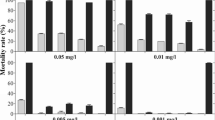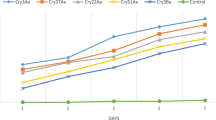Abstract
Simple biochemical means were used to enhance the endotoxin effect ofBacillus thuringiensis Berliner through optimization of conditions present in the insect gut required for release of intoxicating fragments from nonpoisonous intact endotoxin. This was achieved through the addition of either alkaline compounds naturally occurring in the insect midgut, general proteolytic activators or midly toxic compounds of inorganic (e.g. borax) and organic (e.g. tannic acid) nature along with endotoxin in the diet. A marked increase in the potency ofB.t. vars.entomocidus HD-635 andaizawai HD-133 againstSpodoptera littoralis (Boisduval) was obtained in the presence of 0.5% concentration of potassium carbonate. On the other hand, sodium carbonate was less effective at the tested concentrations. Among the tested proteolytic activators, the effect of magnesium ion was proportional to the concentration of the incorporated salt. Thus the potencies of δ-endotoxin preparations of HD-635 and HD-133 were increased 2–3 times after the addition of 1% concentration of magnesium chloride. A lesser effect was noted at 0.5%, whereas virtually the potency did not change at 0.25% concentration of the salt. Similar trends were noted with the incorporation of calcium chloride along with the endotoxin in the insect diet. The addition of sodium borate or tannic acid was highly effective in enhancing the potency of the tested sporeδ-endotoxin preparations with 2–4 fold increase.
Résumé
Des moyens biochimiques simples sont utilisés pour accroître l'action deBacillus thuringiensis Berliner par une optimisation des conditions dans le tube digestif de l'insecte, de façon à obtenir la formation de fractions toxiques à partir de l'endotoxine intacte non toxique. Ce processus a été réalisé par l'addition à l'endotoxine dans l'aliment, soit de composés alcalins naturellement présents dans l'intestin moyen, en général des activateurs de la protéolyse, soit de produits moyennement toxiques de nature minérale (borax) ou organique (acide tannique).
Une augmentation nette de l'activité deB.t. var.entomocidus HD 635 HD 635 etaizawai HD 133, contreSpodoptera littoralis (Boisduval) a été notée en présence d'une concentration de 0,5% de carbonate de potassium. Par contre, le carbonate de sodium a été moins actif aux concentrations étudiées. Parmi les activateurs de protéolyse testés, l'ion magnésium a eu un effet proportionnel à la concentration. Le pouvoir toxique des préparations à base de δ-endotoxine de HD 635 et HD 133 a été accru de 2 à 3 fois avec l'addition de 1% de chlorure de magnésium. Un effet moindre a été enregistré avec 0,5% et il n'y a pas eu de modification de l'activité avec 0,25%.
Des tendances analogues ont été notées avec du chlorure de calcium dans l'aliment. L'addition de borate de sodium ou d'acide tannique s'est révélée hautement efficace pour l'accroissement de 2 à 4 fois du pouvoir toxique des préparations de spores et d'endotoxine utilisées.
Similar content being viewed by others
References
Abbott, W.S. — 1925. A method of computing the effectiveness of an insecticide. —J. Econ. Entomol., 18, 265–267.
Burges, H.D. — 1977. Control of the wax mothGalleria mellonella on beecomb by H-serotype VBacillus thuringiensis and the effect of chemical additives. —Apidologie, 8, 155–168.
Charles, C.D. &Wallis, R. — 1964. Enhancement of the action ofBacillus thuringiensis var.thuringiensis onPorthetria dispar (Linn.) in laboratory tests. —J. Insect Pathol., 6, 423–429.
Couch, T.L. &Ross, D.A. — 1980. Production and utilization ofBacillus thuringiensis. —Biotechnal & Bioengin, 22, 1297–1304.
Dixon, M. &Webb, E.C. — 1964. Enzymes. —Academic Press Inc., New York, 67–70.
Dulmage, H.T., Boening, O., Rehenborg, C. &Hansen, G. — 1971. A proposed standardized bioassay for formulations ofBacillus thuringiensis based on the international unit. —J. Invertebr. Pathol., 18, 240–245.
Govindarajan, R.S., Jayaraj, S. &Narayanan, K. — 1975. Observations ontthe nature of resistance inBacillus thuringiensis Berliner. —Indian J. Exp. Biol. 13, 548–550.
Heimpel, A.M. &Angus, T.A. — 1959. The site of action of crystalliferous bacteria in lepidoptera larvae. —J. Insect Pathol., 1, 152–170.
Heimpel, A.M. &Angus, T.A. — 1960. Bacterial insecticides. —Bacteriol. Rev., 24, 266–288.
Lecadet, M.M. &Martouret, D. — 1965. The enzymatic hydrolysis ofBacillus thuringiensis Berliner crystals and the liberation of toxic fractions of bacterial origin by the cycle ofPieris brassicae. —J. Invertebr. Pathol., 7, 105–108.
Narayanan, K., Govindarajan, R. &Jayaraj, S. — 1976. Role of alkali components and gut microflora ofPapilio demoleus L. andSpodoptera litura F. in the mode of action ofBacillus thuringiensis Berliner. —Madras. Agric. J., 64, 344–346.
Salama, H.S. — 1970. Rearing the corn borerOstrinia nubilalis Hübn. on a semiartificial diet. —Z. Angew. Entomol., 65, 216–218.
Salama, H.S., Foda, M.S., Sharahy, A. & Selim, M. — 1983. Utilization of fodder yeast and other industrial byproducts in the production of endotoxins ofBacillus thuringiensis. —Zentral Blatt Mikrobiol.,
Smirnoff, W.A. — 1974. The symptoms of infection byBacillus thuringiensis and chitinase formulation in larvae ofChoristoneura fumiferana. —J. Invertebr. Pathol., 23, 397–399.
Author information
Authors and Affiliations
Rights and permissions
About this article
Cite this article
Salama, H.S., Foda, M.S. & Sharaby, A. Novel biochemical avenues for enhancingBacillus thuringiensis endotoxin potency againstSpodoptera littoralis [Lep.: Noctuidae] . Entomophaga 29, 171–178 (1984). https://doi.org/10.1007/BF02372106
Issue Date:
DOI: https://doi.org/10.1007/BF02372106




